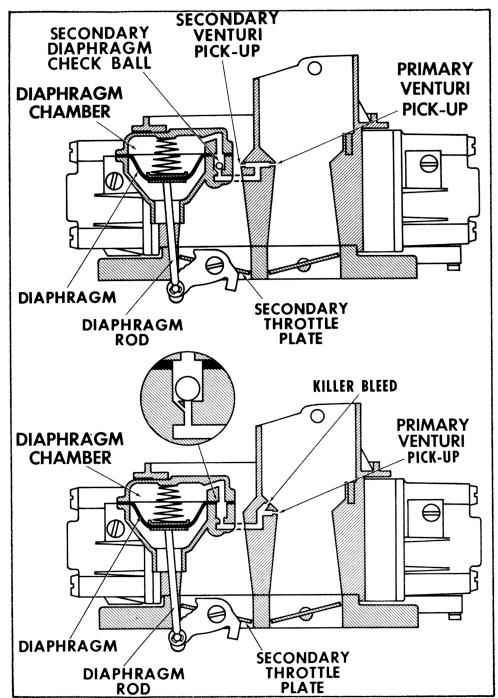 |
|
|
|
|
| |
the strength of the vacuum. This in turn, is deter
mined by the air-flow through the bores to the
engine. As the air-flow increases, a greater sec
ondary throttle plate opening will result and the
secondary bores will supply a greater portion of
the engine's requirements.As top speed is reached,
the secondary throttle plates will approach wide
open. |
|
| |
|
|
|
| |
The bleed past the ball check valve in
the vacuum passage of this carburetor limits the
rate at which the secondary throttle plates are
allowed to open. Any rapid increase in vacuum,
which would tend to open the secondary throttle
plates too suddently, merely holds the ball check
valve securely against its seat. The opening of the
throttle plates is slowed to a rate governed by the
amount of air passing through an air bleed in the
check valve seat. On some units this bleed is a
groove in check ball seat. On other units this is
a drilled by pass. This allows the vacuum to build
up comparatively slowly at the diaphragm which
results in a controlled rate of opening for the
secondary throttle plates. As the secondary
throttle plates begin to open, a vacuum is created
in the secondary bores, first at the throttle plates
and then, as air flow increases, at the throat of the
secondary venturi. This vacuum assists the sec
ondary metering system to operate. |
|
| |
|
|
|
| |
|
|
|
|
|
|
|
|
|
| |
|
|
Secondary Throttle Operating System |
|
|
|
When engine speed is reduced, venturi
vacuum in the bores become weaker. The momen
tarily stronger vacuum at the secondary throttle
operating diaphragm moves the ball check valve off
its seat in the vacuum passage, permitting an
immediate flow of air into the diaphragm chamber.
As the vacuum acting on the diaphragm is lessened,
the load on the diaphragm spring will commence
closing the secondary plates. The diaphragm
spring is assisted by the design of the secondary
plates. Each secondary plate is slightly offset.
When the plates are closing, the combined force
of manifold vacuum and the air stream has greater
effect on the larger, upstream area of the plates,
forcing the plates to a closed position. The
secondary plates are retained in the closed posi
tion when the primary plates are fully closed by
the secondary throttle connecting rod. This rod,
which is fastened to the primary throttle lever,
rides in a slot in the secondary throttle lever. |
| |
|
|
|
|
|
|
|
| |
3. ACCESSORIES |
|
|
|
|
| |
|
|
|
|
|
|
|
| |
|
A. SECONDARY THROTTLE OPERATION |
|
|
| |
|
|
|
|
|
|
|
| |
(1) VACUUM - All four barrel carbure
tors except 4160 with Mechanical Secondarys. |
|
|
| |
|
|
|
|
|
|
|
| |
At lower speeds, the secondary throt
tle plates remain nearly closed, allowing the
engine to maintain satisfactory fuel-air ratios and
distribution. When engine speed increases to a
point where additional breathing capacity is
needed, the vacuum controlled secondary throttle
plates begin to open. |
|
|
| |
|
|
|
|
|
|
|
| |
Vacuum taken from one of the primary
bores and one of the secondary bores acts upon a
diaphragm which controls the secondary throttle
plates. On Model 4150-G the two pick-up ports are
located in the primary barrel only. At high speeds
when engine requirements approach the capacity of
the two primary bores, the increased primary
venturi vacuum moves the diaphragm, compres
sing the diaphragm spring. The diaphragm, acting
through the diaphragm link and lever, will com
mence to open the secondary throttle plates. The
position of the secondary throttle plates depends on |
|
|
| |
|
|
|
|
| |
|
|
(2) MECHANICAL - MODEL 4160 WITH
MECHANICAL SECONDARYS - The secondary
throttle plates on this carburetor are connected
by linkage to the primary throttle linkage and are
mechanically operated. |
| |
|
|
|
|
| |
|
|
As the primary throttle plates con
tinue to open as accelerator pedal pressure is |